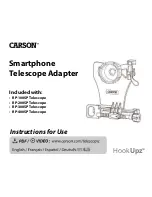
11
Most helmets have ear pockets
(indentations) designed into the lining to let
your ears fold back after they are folded over
while putting the helmet on. Sometimes the
fabric covering these ear pockets is glued
back to the polystyrene cheek pad, forming a
visible pocket. Other times the fabric is just
stretched over the foam pocket and is not
glued back.
If the helmet has deep pockets and the
fabric is glued back
you may need to fit
some padding behind the speakers (like our
optional foam speaker pads Part 2159 which
are about 6mm or
1
⁄
4
” and/or Part 2160 which
are about 12mm or
1
⁄
2
”). These foam speaker
pads have Velcro fitted so that you can fix the
speakers to them.
Always start without any
padding and with the speakers set
deliberately low, then test for comfort/sound
quality. Then pack out and/or adjust up to
the correct positioning over your ear hole,
thus avoiding having the speaker too high or
tight where it may cause excessive pressure
to the top part of your ears.
If the fabric is not glued back forming a
visible pocket
then while it is easier to just
Velcro the speakers on top of the loose fabric
(which can sometimes work quite well in
some helmets) it is far more likely to cause
your ears to fold over when putting the
helmet on, so most people prefer a more
professional installation where the speakers
are set behind the fabric but on top of the
foam/polystyrene behind.
If you have time
and can install the speakers behind the
fabric, it makes for a much more
professional semi permanent fitment, which is normally much more comfortable
and this is
how we would normally try to install the headset/s for you if you brought them to us.
In order to be able to place the speakers behind the fabric you normally need to remove the cheek pads
from the helmet to reveal the back where the fabric is glued, taped or preferably just elasticated over
the polystyrene.
Carefully
peel the fabric back enough to slide the speakers into place (normally about
level or just below the level of the hole for the strap and just behind the strap). Try to copy the
illustrations on pages 8 and 9. Again it is important to start with the speakers set deliberately lower to
help with maximum comfort and avoid pinching the top part of your ears, and then adjust them
upwards as required to obtain the best sound level and quality. If you have to un-glue or un-tape the
fabric, masking tape is often used to stick this back down
Please see illustration on page 7 and note that by angling the speakers as shown it helps to ensure even
pressure between the speakers and your ears, thus improving both comfort and sound quality. The
speaker wire normally exits the speaker towards the back of the helmet.
Only if you have tried everything else
first, use your thumb (or something harder, smooth and
rounded like the back of a screwdriver handle) to carefully compress JUST ENOUGH of the polystyrene
for the wires, boom and loom to slightly recess into the polystyrene to help relieve any pressure. This
would NOT normally require more than just 1 or 2 mm (
1
⁄
16
”).
Top Tips (7)
If your cheek pad has a plastic tongue to hold it in place, be careful not to break this off when
removing or replacing the cheek pads, and also be careful not to trap or cut the speaker wire/s with
it when replacing the cheek pads. When you have installed the headset you can use the back of a
toothbrush handle to make a great tool for carefully pushing any wires up into the lining and around
the back of the neck draft excluder. You may find it is better to fix the speakers with Velcro so as to
help avoid them slipping up inside the helmet which can happen over time due to movement when
putting the helmet on.
For the first time putting the helmet on after installation it is often beneficial
to use something like a silk balaclava to help prevent your ears being folded over while putting the
helmet on and off until you have fine tuned the speaker positioning for maximum comfort and
performance. If for example your right ear is folded over after putting the helmet on you should
immediately use your right hand to pull the right hand strap so that you can get your left hand
fingers up into the right hand side of the helmet to flick your right ear back straight etc.
while doing
this you may also be able to feel the speaker position in relation to your ear and if possible try to
move the speaker for a better fit/sound.
Please visit our website: www.autocom.co.uk for further helmet fitting instructions.
SPEAKER INSTALLATION
Super Pro Auto Instructions 8/5/09 2:24 pm Page 11






































